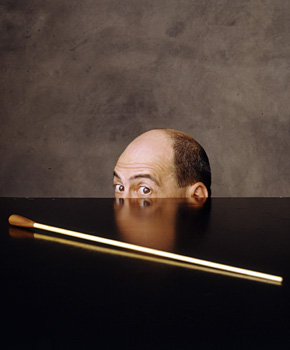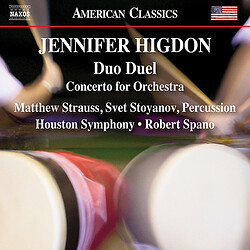EarRelevant, July 31, 2023
Robert Spano and Houston Symphony capture the rhythmic brilliance of Jennifer Higdon’s music in new CD
When characterizing the compositional style of Jennifer Higdon, one word immediately comes to mind: rhythm.
Higdon has many outstanding characteristics: exceptional bravura of orchestration and great inventiveness of colors. But her best quality ever is her capacity to build sound constructs of energy and speed which are breathtaking.
On this Naxos American Classics CD, we can listen to a first-time recording of Duo Duel (2020) for two percussionists and orchestra and a Concerto for Orchestra (2002).
Both works are directed with great precision and sense of dynamics by the conductor Robert Spano and played by the spectacular Houston Symphony Orchestra.
Since, as said, the rhythm is of particular interest for Ms. Higdon, it is only logical that she gives much attention to the percussion.
Duo Duel, with its nearly 24 minutes in a single movement, starts with some noninvasive sounds, slightly recalling a Christmas atmosphere. Nothing warns the listener about what is coming next. While the orchestra slowly steps in, an absolute orgy of contrasting rhythmical cells, micro themes, so to say, builds up. The orchestral interludes have their generous space to let the two brave percussionists, Matthew Strauss and Svet Stoyanov, breathe and regain energy.
Towards the end, there is one last cadenza, where the percussionists are playing one against the other, the speed obtained is something rarely heard before. In the big finale, the layers of different orchestral sections become so thick that even the skilled listener has difficulty digesting it all.
Higdon uses the percussion in a rather traditional way, rarely using special playing techniques, except for using a string instrument bow to play the vibraphone. Still, even with this self-imposed limitation, we get a score that is never boring and successfully obtains an ever-changing carpet of colors.
Using Concerto for Orchestra as a title immediately recalls some precedent works with the same name. To cite the two most famous: Bartok and Lutoslawski.
Being divided into five sections, where the fourth and the fifth are “attacca,” once again, most of Higdon’s music is loaded with adrenaline. The slow sections are rare; if present, they are underlined with some sort of pulsation that voluntarily disturbs the quiet.
Here Robert Spano delivers a real firework of precisely crafted passages without any uncertainty, a true wonder of a symbiosis of a conductor and his orchestra.
Ms. Higdon uses a quite traditional orchestration, never using “exotic” instruments and avoiding even instruments like piano or harpsichord, which are pretty common.
When listening to Bartok and Lutoslawski, it seems that their common goal is to create a sense of “before” and “after” where themes are returning, well-spaced with calmer sections, building a well-planned sound surface, giving the listener time to adjust and enjoy.
The approach of Ms. Higdon is a very different one.
Her music, similar to a lava stream, proceeds forwards without caring much about what happened before, and if sometimes a theme returns, it is mostly transformed beyond recognition. Good examples are the fourth and fifth sections of the orchestra concerto.
As she explains in the booklet, the speed is constantly augmented throughout the duration, reaching a difficult-to-beat climax.
This disc is a clear recommendation to anybody who admires the music of our century but prefers to avoid venturing into too-experimental fields

 Back to List
Back to List